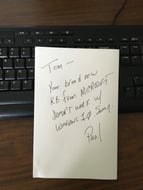
With business operations more dependent on desktop computing than ever, the smallest glitch can bring productivity to a halt. Even the simplest computing problem can render your workstation useless and business stops. It’s like the old adage “For want of a nail… the kingdom was lost.” Let me share a recent experience that illustrates my point.
 The other day I decided to upgrade my computer keyboard. After using a Logitech wireless keyboard for some time I decided to upgrade to a new Microsoft ergonomic keyboard. The keyboard felt much better and had a more useable layout and everything was great, until I updated my Windows 10 operating system.
The other day I decided to upgrade my computer keyboard. After using a Logitech wireless keyboard for some time I decided to upgrade to a new Microsoft ergonomic keyboard. The keyboard felt much better and had a more useable layout and everything was great, until I updated my Windows 10 operating system.
 You’re undoubtedly are familiar with those automatic updates, where the system automatically downloads new software and it takes 15 minutes to install the software upgrades. Once I updated Windows 10, I logged back in the system and it worked fine for a moment, then generated a random error code and I had to reboot the system. Once I rebooted the system was fine, until another random error forced me to reboot again, and again. You get the idea.
You’re undoubtedly are familiar with those automatic updates, where the system automatically downloads new software and it takes 15 minutes to install the software upgrades. Once I updated Windows 10, I logged back in the system and it worked fine for a moment, then generated a random error code and I had to reboot the system. Once I rebooted the system was fine, until another random error forced me to reboot again, and again. You get the idea.
I couldn’t quickly identify the problem so I called our help desk and headed out to a meeting.
When I returned, I found another keyboard on my desk with a wired connection and a note from my help desk tech, “Sorry, your new keyboard doesn’t work with the latest Windows 10 update.” It seems the keyboard was incompatible with the hardware and the OS combination, although there is an online fix, and Microsoft plans to address the problem in the next upgrade, and so on.
returned, I found another keyboard on my desk with a wired connection and a note from my help desk tech, “Sorry, your new keyboard doesn’t work with the latest Windows 10 update.” It seems the keyboard was incompatible with the hardware and the OS combination, although there is an online fix, and Microsoft plans to address the problem in the next upgrade, and so on.
While I was annoyed, I also realized that because we had a top notch help desk staff, my problem had been resolved quickly and efficiently. It seems that our help desk team had encountered the same problem with some of our clients, was aware of the issue, and therefore knew how to fix the problem and get my workstation back with minimal disruption.
Now consider that you may have a small business with 20 employees but no available help desk. If five users or 25 percent of your workforce have the same keyboard and are affected in the same fashion, they would try rebooting their system to no avail. They would probably consult a coworker for help, so now you have as many as 10 people or 50 percent of your workforce whose productivity has been disrupted. They work together to find a resolution, searching online for a solution, testing links with possible bug fixes, etc. It may take one to two hours to determine they can’t find a fix for the problem, so you now have two employees who have wasted four hours of work time between them trying to address a computer issue. If you multiply that by 10 employees that’s 40 hours or an entire work week with no productivity, and you still haven’t resolved the problem.
That one incident would more than pay for external help desk support. If you have our NSI Total Care service, for example, a single phone call would have taken care of the problem. We have the capability to log in to your system to resolve the problem remotely, and then provide a resolution in a fraction of the time so you would lose minutes of productivity, not hours. Once the problem had been identified we also would proactively contact other employees that could be affected. The result is a minimal loss in productivity.
So what’s the moral of the story? It’s more cost effective to have a qualified help desk staff ready and available when you need it. Managed services are an insurance policy, just as you have systems backup and disaster recovery in place to protect critical data. Having managed services available can provide expert troubleshooting when you need it so your staff can stay up and running, and productive. After all, for want of a nail…







